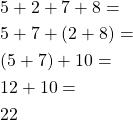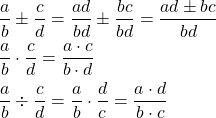Mathematics - All About Simplifying Expressions

Introduction
Hey it's a me again @drifter1!
Today's article is another high-school refresher on Mathematics, and more specifically on Simplifying Expressions. It's a follow-up to the previous posts about Polynomial Arithmetic and Rational Expressions, where we will cover the simplification process more thoroughly.
So, without further ado, let's dive straight into it!
Expansion
Expanding an expression is the process of removing the parentheses or brackets from it. When removing it is important to not make any mathematical or algebraic errors.
For example, multiplying a sum by a number, the result should be another sum where each term of the sum is multiplied by that number, as shown in the following example.

Of course, the sum within the parenthesis could be calculated first, making it a simple 3 times 10 calculation. But, this was basically just a proof of concept. Usually, the expansion will be a multiplication of polynomials, where one might even be a simple constant or monomial.
The following polynomial multiplication is an example of expansion.

Laws
Distributive Law
The expansion of expressions is one of the 3 important properties of algebraic expressions, known as the Distributive Law or the distributivity property, which can be written as:

Associative Laws
The Associative Law tells us that the order of grouping numbers into sums or products doesn't matter. It's the property known as associativity. In other words, it doesn't matter which individual addition or multiplication we calculate first. The only thing that matters is that the correct priority (precedence) of the individual operators is applied. It's important that the law doesn't work for subtraction or division.
Below is a simple mathematical definition of the laws.

Commutative Laws
The Commutative Law or commutativity property tells us that swapping the order of the numbers within a sum or product doesn't affect the result. It again doesn't apply for subtraction or division.
Mathematically:

Example
For example, take a look at the expression below.

Of course, it's more straightforward to calculate the sum of 8 and 2 first in order to get 10.
These various ways in which we group the numbers within the expression are the result of associativity and commutativity. It's something that many of us tend to do unconsciously!
Cross-Multiply
In an equation of two fractions, the process of eliminating the fractions by cross-multiplying the tops and bottom is known as cross-multiplication.

For example:

Proportions
Two fractions can look different but define the same proportion. For example, a third and two-sixths is the same proportion. The second fraction is simply not in lowest terms, as there is a common factor of 2.
Using cross-multiplication its easy to calculate the missing numerator of denominator in order to yield the same proportion.
For example:

Percentage
A percentage is also a ratio! It's just a fraction with 100 in the denominator, which is shortened to a number followed by %. Thus, it's easy to use cross-multiply in that case as well, in order to calculate the amount of parts or the percentage, as shown below.

For example, if we have 20% of 150 how much do we have?

Fraction Arithmetic
Fractions can be added, subtracted, multiplied and divided, like shown below.

Multiplication is the simplest operation. When multiplying fractions we multiply the numerators and denominators together.
Division is the multiplication by the reciprocal ("flip") of the fraction we wish to divide by. It can also be thought of as multiplying the outer and inner parts of the complex fraction together.
When adding or subtracting the numerators are added together, whilst having a common denominator. Ending up with a common denominator is as simple as top-bottom multiplying each fraction by the denominator of the other fraction.
Factoring
The process of reversing the multiplication of polynomials is known as factoring (or Factorising).
Numbers have factors as they can be represented as a product of other numbers.
For example:

Similarly, in the context of polynomials, we try to find factors like constants, monomials and other polynomials in general, in order to turn the polynomial into a product.
For example:

This product is the result of solving the polynomial, as -2 and 1 are the solutions. Fiding the roots of polynomials will be covered in a follow-up article.
Common Factor
The simplest form of factoring is about finding the highest common factor. This factor is mostly a constant or a simple monomial of the form axb.
Below we can take the monomial 2x as the common factor:

Taking only x, which is not the highest common factor, would require taking 2 afterwards as well, in order to undo all the multiplications.
Squares and Cubes of Binomials
Identifying squares and cubes of binomials also allows for some pretty neat simplifications.
Some commonly applied rules are:

Other Common Identities
Let's also not forget to mention the difference of squares, and sums and differences of cubes, which allows for factoring and expansion:

Grouping Terms
Factoring is all about exploring multiple paths, where different parts of the polynomial are chosen each time. Sometimes it might also be useful to add a well-chosen expression which gives a value of zero, in order to identify a common factor. The main goal of such an expression is to end up with square and or cube identities.
Full-On Example
Let's consider the expression below:

The middle term can be turned into a sum:

Now it's easy to identify common factors for the two sections of the expression:

Lastly, there is now the common factor (x + 1), which gives us the final result:

RESOURCES:
References
- https://www.mathsisfun.com/algebra/index.html
- http://mathcenter.oxford.emory.edu/site/math100/factoring/
Mathematical equations used in this article, have been generated using quicklatex.
Block diagrams and other visualizations were made using draw.io.
Final words | Next up
And this is actually it for today's post!
The next "All About" articles will be about:
- Solving Polynomial Equations
- Exponentials and Logarithms
Basically more High-School Math Refreshers!
See ya!

Keep on drifting!